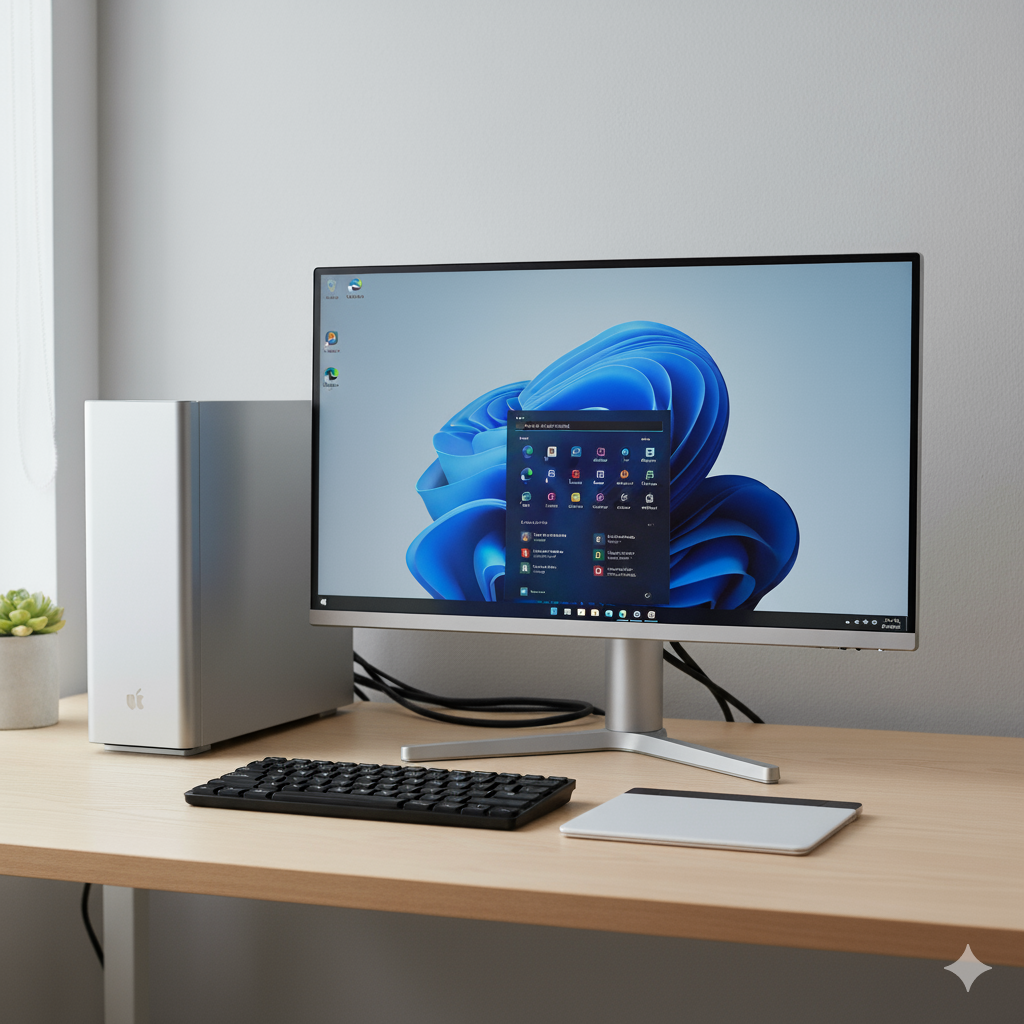Apple Magic Trackpad with Windows 11 Intel
- Category: Windows OS
- Hits: 7709
A quick article to get an Apple Trackpad working with an MS Windows 11 Pro (Intel 64) workstation.
Why?
I forgot my work Macbook at home and rather than drive the commute back and forth again, I took my previous biscuit box out (a Dell MFF Optiplex 7070) and spent 30 minutes connecting monitors and the logitech receiver for my keyboard (which was a Logitech keyboard for Windows - keys switched for the Mac but reverted for the biscuit box). Running MS Windows 11 pro already. Wifi was ok to connect and my Microsoft Office apps, well it's a Windows box so no issues there either... Webcam and headset previously connected to my docking station weren't too much of an issue either as MS Windows detected these without needing software.
Long rant to justify why I didn't want to drive home (~20 to 40 minutes commute) and pick up my laptop.
How?
The work and research for this was all in one YouTube video by LinxHype (https://www.youtube.com/watch?v=J_z9-rE_6zI) so I don't want to take credit for it. There were other videos using the GitHub repo: GitHub / imbushuo / mac-precision-touchpad but those instructions seemed only for those on an AMD or ARM processor. The process demo'd by LinxHype is the one that worked for me.
Windows 7: System Clock is constantly going out of sync
- Category: Windows OS
- Hits: 235148
The Issue
People have reported that although they have manually set the date/time on their computer, this gets changed by the windows time server (time.windows.com) when connected to the Internet and for some reason it doesn't display the right date/time.
The Quick Fix
First off, check there aren't any Update for Windows 7 releases at Microsoft's Windows Update
Windows OS: Alt Codes / Symbols / Special Characters
- Category: Windows OS
- Hits: 26824
This is a simple article to demonstrate how to type special characters not found on your keyboard or on a Qwerty UK/US keyboard layout.
Why?
Being able to type international characters from other alphabets is necessary when dealing with languages other than English. Preserving files in unicode or utf-8 encoding will help but there will be times when you have lost the formatting and get weird question mark characters instead such as: .
How?
Ensure you are using the numbers on your numeric keypad and NOT the numbers at the top of your keyboard for the following steps. Also check that you have "Num Lock" on/enabled. Typing a special character is 3 easy steps:
- Hold down the ALT key (preferably the one on the left of the spacebar and not the Alt Gr often found on the right of the spacebar)
- then press the numbers in the numeric pad (while still holding down the ALT key),
- then let go of the ALT key.
Hide a Drive per User in Windows 7
- Category: Windows OS
- Hits: 36862
- Microsoft Windows 7 Professional
Looking at ways of displaying different drives per user on a single computer. This one is by modifying the system registry, so if you aren't familiar with the system registry in MS Windows, you may need to find someone who is.
How?
As a proof of concept, let's see how to hide a specific drive. Note that this section applies to the currently logged-in user.
Windows 10: Shortcut Apps to Settings
- Category: Windows OS
- Hits: 37226
- Microsoft Windows 10 Pro v10.0.18362
This is a list of apps that if run via the run command, or used in a desktop shortcut, or that you want to include in automation software such as AutoHotkey, opens any specific Windows OS settings page. This does not make the change to the setting itself, just displays it to the user for them to make the choice.
Why?
I needed a command that can be run from the command-line in an AutoHotkey app to open the notifications page of the Windows 10 Settings panel to allow users to enable/disable notifications. Why write this article when there's a perfectly ok post on the Microsoft website? Well I could bookmark that page or save myself a click...
How?
To test any of the following, type the windows key and select "Run..." ( + R). Then type the value in the 2nd column "App to Run" then OK to run it:
Windows Live Mail Error ID: 0x8DE00005
- Category: Windows OS
- Hits: 18637
- Windows Live Mail 2012
A quick article on how to update the Microsoft Live Server URL for Hotmail using Windows Live Mail. Well how to deactivate an account and set up a new one in Windows Live Mail. If you used IMAP all along then the new account will have all your mail.
The error
Unable to send or receive messages for the Hotmail (someone) account. Subject 'your Microsoft Issue' Server Error: 3219 Windows Live Mail Error ID: 0x8DE00005 Unable to send or receive messages for the Hotmail (someone) account. Server Error: 3219 Server: 'https://mail.services.live.com/DeltaSync_v2.0.0/Sync.aspx' Windows Live Mail Error ID: 0x8DE00005
How?
I don't remember the time when the Microsoft website became helpful but as they already have an article on this, I'm going to do a bunch of screenshots:
VBScript to retrieve Windows Product Key
- Category: Windows OS
- Hits: 14389
A quick article with the code to retrieve your product key in Windows 7 with a small VB script file. There are other articles on the web about this but the ones I found returned errors such as WshShell not valid. This article has a working example applicable to Windows 7 Professional.
Why?
With the Windows 10 operating system offered as a free upgrade (for Windows 7 or later at time of print), I needed the serial number / product key from my Windows 7 Professional 32-bit operating system. I didn't want to dig through my CD/DVDs to find my original windows 7 disc and no longer have access to the email account when I purchased Windows 7 (my university one).
How?
I'm going to use my trusty notepad program, copy the following code to it, and run it:
Making a CD copy with only one drive
- Category: Windows OS
- Hits: 24917
This is in the case that you have only one optical drive which is a minimum of a CD Writer and you want to make a copy of a CD.
- Insert original CD in the drive
- In the CD Drive dialog box, click CANCEL
- On the desktop, double-click on MY COMPUTER
- Right-click on the CD drive and select OPEN
- Go to EDIT > SELECT ALL > EDIT > COPY
- PASTE to a temporary folder
- Select all the files, right-click on them and select SEND TO > DIRECTCD
Page 1 of 3
Credit where Credit is Due:
Feel free to copy, redistribute and share this information. All that we ask is that you attribute credit and possibly even a link back to this website as it really helps in our search engine rankings.
Disclaimer: Please note that the information provided on this website is intended for informational purposes only and does not represent a warranty. The opinions expressed are those of the author only. We recommend testing any solutions in a development environment before implementing them in production. The articles are based on our good faith efforts and were current at the time of writing, reflecting our practical experience in a commercial setting.
Thank you for visiting and, as always, we hope this website was of some use to you!
Kind Regards,
Joel Lipman
www.joellipman.com
Latest Articles
Accreditation



Donate & Support
If you like my content, and would like to support this sharing site, feel free to donate using a method below:

 bc1qf6elrdxc968h0k673l2djc9wrpazhqtxw8qqp4
bc1qf6elrdxc968h0k673l2djc9wrpazhqtxw8qqp4
 0xb038962F3809b425D661EF5D22294Cf45E02FebF
0xb038962F3809b425D661EF5D22294Cf45E02FebF
Paypal:

Bitcoin:
 bc1qf6elrdxc968h0k673l2djc9wrpazhqtxw8qqp4
bc1qf6elrdxc968h0k673l2djc9wrpazhqtxw8qqp4
Ethereum:
 0xb038962F3809b425D661EF5D22294Cf45E02FebF
0xb038962F3809b425D661EF5D22294Cf45E02FebF








